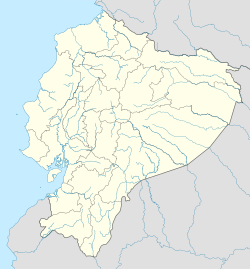This article needs additional citations for verification .(January 2011) |
Salinas | |
|---|---|
City | |
 | |
| Coordinates: 2°13′00.12″S80°57′00.24″W / 2.2167000°S 80.9500667°W | |
| Country | |
| Province | Santa Elena |
| Canton | Salinas |
| Parishes | List of urban parishes
|
| Government | |
| • Mayor | Dennis Córdova |
| Area | |
• City | 13.38 km2 (5.17 sq mi) |
| • Metro | 73.5 km2 (28.4 sq mi) |
| Population (2022 census) [1] | |
• City | 35,066 |
| • Density | 2,600/km2 (6,800/sq mi) |
| • Metro | 200,000 |
| (incl. La Libertad and Santa Elena) | |
| Time zone | UTC-5 (ECT) |
| Climate | BWh |
| Website | http://www.salinas.gob.ec/ |
Salinas is a coastal city located in the Province of Santa Elena, Ecuador. It is the seat of the canton that bears its name. The westernmost city on mainland Ecuador, Salinas is an important tourist center. Salinas, Ecuador's largest coastal resort, offers one of the country's best real estate investment markets and most popular and most upscale beach lifestyle. It was the site of the ISA World Junior Surfing Games Ecuador in 2009. There are two major yacht clubs in Salinas, the first is Salinas Yacht Club, which is smaller than the Puerto Lucia Yacht Club, in Santa Elena, in an area known as 'La Libertad' which, in Spanish means 'The Freedom Town'. Puerto Lucia boasts a hotel, several restaurants, a private beach and apartment buildings, as well as the large marina and port.
Contents
- Political division
- Economy and attractions
- Salinas Museum 21st Century
- Punta Carnero Beach
- Other attractions
- Geography
- Climate
- References
It was a small fishing village until June 30, 1929, when it was established as the rural parish of Santa Elena. On December 22, 1937, an official decree was signed by the Commander in Chief, General Alberto Enriquez Gallo and published in Official Gazette No. 52 of December 27 of that year, that elevated the parish to the rank of canton. Its cantonal head is the town of Salinas, and is composed of the rural parishes Ancon, and Jose Luis Tamayo Anconcito (Muey).





